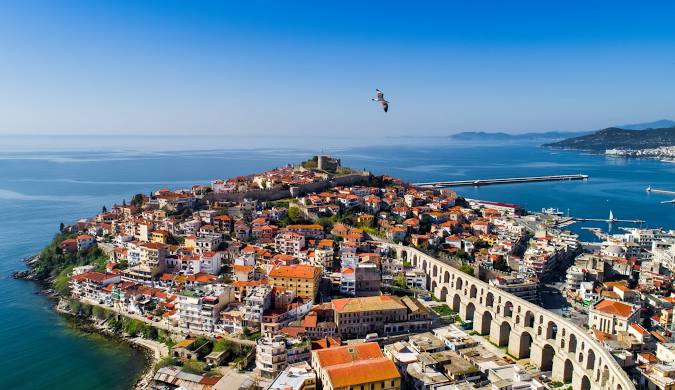Kavala is one of the most beautiful cities of Greece. Built amphitheatrically on the foothills of Mt. Symvolo, what was once known as the “Mecca of tobacco” maintains many elements of its old self. The pride of the town is its imposing Kavala fort, the Acropolis. It stands at the summit of the Old Town within the walls of an external enclosure. The largest section of the fortress was built in the first quarter of the 15th century CE, during Byzantine times, but renovation by the Ottomans in 1425 gave it its present form. The city’s trademark is its tobacco warehouses.
From the mid-19th century to the decade of the 1950s, Kavala was the largest center for tobacco processing and trade in the Balkans. In 1896, the first and largest labor strike in the Balkans involving 5,000 workers, took place.
The Bulgarian army occupied the city in October 1912, which was then liberated in 1913 by the Greek fleet anchored in Thasos, only to be once more taken over by the Bulgarians in 1916. In 1918, with the end of the WWI, the city was again liberated. In the wake of the Asia Minor catastrophe, Kavala was flooded with refugees from Eastern Thrace, Eastern Rumelia and Asia Minor, who also brought with them their great cultural tradition. The Bulgarian presence in Kavala (1941) in the form of WWII military occupation was the result of an agreement between Germany and Bulgaria. The region was finally liberated in 1944 and became part of Greece.
Gastronomy
It goes without saying that in Kavala, one of the largest fishing centres in the country, fresh fish and seafood reign supreme. There, you will find fish taverns in the eastern parts of the city, in Sfagheia and Perigiali.
The cuisine combines local Macedonian recipes with the influences it received from the cuisine of refugees from the Pontus, Asia Minor and Cappadocia.
Salt-cured fish, or gouna (mostly mackerel but Tinker mackerel as well, dried in the sun and then grilled), sardines, mussel pilaf, herring saganaki, anchovy wrapped in vine leaves, and stuffed aubergines are just some of the typical dishes of the area.




